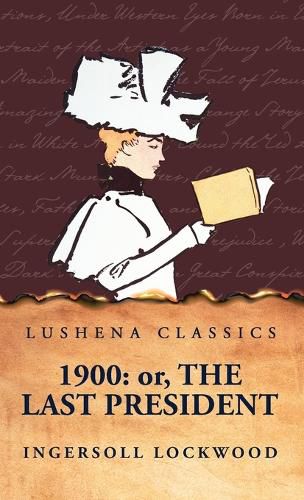Readings Newsletter
Become a Readings Member to make your shopping experience even easier.
Sign in or sign up for free!
You’re not far away from qualifying for FREE standard shipping within Australia
You’ve qualified for FREE standard shipping within Australia
The cart is loading…






This title is printed to order. This book may have been self-published. If so, we cannot guarantee the quality of the content. In the main most books will have gone through the editing process however some may not. We therefore suggest that you be aware of this before ordering this book. If in doubt check either the author or publisher’s details as we are unable to accept any returns unless they are faulty. Please contact us if you have any questions.
1900: Or, The Last President by Ingersoll Lockwood is a fascinating and somewhat obscure novella published in 1896. It presents a dystopian vision of the United States in political and social turmoil, striking for its eerily prescient parallels to modern times. Though it is less well-known than Lockwood's Baron Trump series, it has attracted significant attention in recent years due to perceived connections between its narrative and contemporary events.
Set in a chaotic future America, the novella opens with the unexpected election of a populist candidate as president. This event triggers widespread civil unrest and economic instability, as the country grapples with deep divisions and dissatisfaction with the status quo. The story describes a fractured society in which the working class rises against the elites, leading to widespread violence, protests, and disorder.
The narrative also weaves in themes of class struggle, corruption, and the erosion of traditional institutions. The title suggests a metaphorical or literal "last president," hinting at the collapse of the American political system or a broader societal decline.
Lockwood wrote the novella during a time of significant social and economic change in America. The late 19th century saw the rise of industrialization, increasing wealth inequality, labor strikes, and debates over monetary policy (e.g., the gold standard vs. free silver). These tensions provide the backdrop for the story's themes of class conflict and political upheaval.
$9.00 standard shipping within Australia
FREE standard shipping within Australia for orders over $100.00
Express & International shipping calculated at checkout
This title is printed to order. This book may have been self-published. If so, we cannot guarantee the quality of the content. In the main most books will have gone through the editing process however some may not. We therefore suggest that you be aware of this before ordering this book. If in doubt check either the author or publisher’s details as we are unable to accept any returns unless they are faulty. Please contact us if you have any questions.
1900: Or, The Last President by Ingersoll Lockwood is a fascinating and somewhat obscure novella published in 1896. It presents a dystopian vision of the United States in political and social turmoil, striking for its eerily prescient parallels to modern times. Though it is less well-known than Lockwood's Baron Trump series, it has attracted significant attention in recent years due to perceived connections between its narrative and contemporary events.
Set in a chaotic future America, the novella opens with the unexpected election of a populist candidate as president. This event triggers widespread civil unrest and economic instability, as the country grapples with deep divisions and dissatisfaction with the status quo. The story describes a fractured society in which the working class rises against the elites, leading to widespread violence, protests, and disorder.
The narrative also weaves in themes of class struggle, corruption, and the erosion of traditional institutions. The title suggests a metaphorical or literal "last president," hinting at the collapse of the American political system or a broader societal decline.
Lockwood wrote the novella during a time of significant social and economic change in America. The late 19th century saw the rise of industrialization, increasing wealth inequality, labor strikes, and debates over monetary policy (e.g., the gold standard vs. free silver). These tensions provide the backdrop for the story's themes of class conflict and political upheaval.